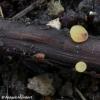
13-04-2017 08:07
 Viktorie Halasu
Viktorie Halasu
Hello forum,I'd like to ask - how do you write det

13-04-2017 10:55
Hi, I am looking for the following literature whic

11-04-2017 17:38
 Mlcoch Patrik
Mlcoch Patrik
Good day everyone on this web,I have problem with

11-04-2017 19:03
Lepista ZacariasDear all,This pyreno was growing on the dead wood

10-04-2017 09:56
François BartholomeeusenDear forum members,On a beetle (Carabus problemati
 Bonsoir à tous,
Bonsoir à tous,Sur une branchette (très probablement aulne) au sol, dans une aulnaie pure.
Apothécies 1,5-3 mm de diamètre, concolores (jaune pâle), très courtement stipitées. Rougissement présent par places, particulièrement visible sur la marge en vieillissant ou à la coupe.
Spores 11 x 3,5 µm, cylindriques et un peu courbées, hyalines, avec une petite goutte à chaque extrémité.
Asques aporhynques et octosporées, ne réagissant pas au liquide de Baral, 60-70 µm de longueur, à parois épaisses.
La micro semble correspondre à Hymenoscyphus vernus mais ici il y a un rougissement...
Merci d'avance pour vos avis !
Andgelo


Andgelo

